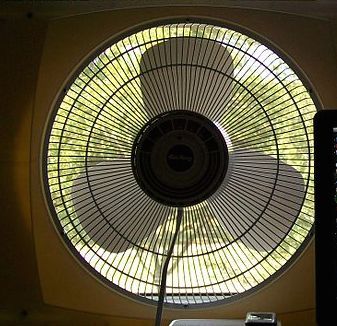A lazy day
 As I was reclining on my couch on a beautiful fall day, I watched the breeze blow through my window fan, thereby making the blades spin. Of course, I immediately thought - nice Brilliant problem! So here it is. My window fan opening is circular with a radius of 0.1 m. If air blows into this opening with a speed of 1 m/s and exits with a speed of 0.9 m/s, how much power is delivered to the blades of my window fan in Watts? You may take the density of air to be
.
As I was reclining on my couch on a beautiful fall day, I watched the breeze blow through my window fan, thereby making the blades spin. Of course, I immediately thought - nice Brilliant problem! So here it is. My window fan opening is circular with a radius of 0.1 m. If air blows into this opening with a speed of 1 m/s and exits with a speed of 0.9 m/s, how much power is delivered to the blades of my window fan in Watts? You may take the density of air to be
.
Assumptions and Details
- Assume that 10% of the air flowing into the fan fan scatters radially (with respect to the center of the fan) away from the window, so as not to contribute to the mass flow through the fan.
Image credit: Wikipedia Nuberger13
The answer is 0.003276995.
This section requires Javascript.
You are seeing this because something didn't load right. We suggest you, (a) try
refreshing the page, (b) enabling javascript if it is disabled on your browser and,
finally, (c)
loading the
non-javascript version of this page
. We're sorry about the hassle.
Consider the work done in t seconds.
W = L o s s i n K i n e t i c E n e r g y = 2 1 m 1 v 1 2 − 2 1 m 2 v 2 2 = 2 1 ( A v 1 t ρ ) v 1 2 − 2 1 ( A v 2 t ρ ) v 2 2 = 2 1 A ρ ( v 1 3 − v 2 3 ) t
Differentiate by time to get power.
P = d t d W = 2 1 A ρ ( v 1 3 − v 2 3 ) = 2 1 ( π r 2 ) ρ ( v 1 3 − v 2 3 )